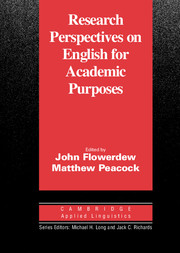Book contents
- Frontmatter
- Contents
- List of contributors
- Series editors' preface
- Preface
- I ISSUES IN ENGLISH FOR ACADEMIC PURPOSES
- II THE ENGLISH FOR ACADEMIC PURPOSES CURRICULUM
- Introduction to Part II
- 11 The EAP curriculum: Issues, methods, and challenges
- 12 Twenty years of needs analyses: Reflections on a personal journey
- 13 The curriculum renewal process in English for academic purposes programmes
- 14 Team-teaching in EAP: Changes and adaptations in the Birmingham approach
- 15 Does the emperor have no clothes? A re-examination of grammar in content-based instruction
- 16 The specialised vocabulary of English for academic purposes
- 17 Language learning strategies and EAP proficiency: Teacher views, student views, and test results
- 18 Issues in EAP test development: What one institution and its history tell us
- 19 Teaching writing for academic purposes
- 20 Reading academic English: Carrying learners across the lexical threshold
- 21 Incorporating reading into EAP writing courses
- 22 The development of EAP oral discussion ability
- 23 Second language lecture comprehension research in naturalistic controlled conditions
- 24 Designing tasks for developing study competence and study skills in English
- 25 Promoting EAP learner autonomy in a second language university context
- References
- Index
19 - Teaching writing for academic purposes
Published online by Cambridge University Press: 05 October 2012
- Frontmatter
- Contents
- List of contributors
- Series editors' preface
- Preface
- I ISSUES IN ENGLISH FOR ACADEMIC PURPOSES
- II THE ENGLISH FOR ACADEMIC PURPOSES CURRICULUM
- Introduction to Part II
- 11 The EAP curriculum: Issues, methods, and challenges
- 12 Twenty years of needs analyses: Reflections on a personal journey
- 13 The curriculum renewal process in English for academic purposes programmes
- 14 Team-teaching in EAP: Changes and adaptations in the Birmingham approach
- 15 Does the emperor have no clothes? A re-examination of grammar in content-based instruction
- 16 The specialised vocabulary of English for academic purposes
- 17 Language learning strategies and EAP proficiency: Teacher views, student views, and test results
- 18 Issues in EAP test development: What one institution and its history tell us
- 19 Teaching writing for academic purposes
- 20 Reading academic English: Carrying learners across the lexical threshold
- 21 Incorporating reading into EAP writing courses
- 22 The development of EAP oral discussion ability
- 23 Second language lecture comprehension research in naturalistic controlled conditions
- 24 Designing tasks for developing study competence and study skills in English
- 25 Promoting EAP learner autonomy in a second language university context
- References
- Index
Summary
The study and teaching of second language writing has gained status as a sub-discipline of both applied linguistics and composition studies over the past decade (Silva, Leki and Carson, 1997). In addition to the emergence of an entire journal devoted to the topic (the Journal of Second Language Writing), a number of books and articles have been published which focus on a wide range of general and specific issues related to the description of second language writers and texts, the teaching of L2 writing, and the preparation of L2 writing teachers (e.g. Belcher and Braine, 1995; Byrd and Reid, 1997; Carson and Leki, 1993a; Connor, 1996; Connor and Kaplan, 1987; Connor and Johns, 1990; Ferris and Hedgcock, 1998; Grabe and Kaplan, 1996; Hamp-Lyons, 1991c; Harklau, Losey and Siegel, 1999; Johnson and Roen, 1989; Kroll, 1990; Leeds, 1996; Leki, 1992; Purves, 1988; Reid, 1993; Tannacito, 1995; Zamel and Spack, 1998).
Though there are many theoretical and practical issues that emerge from these sources, some are particularly salient to the endeavour of teaching L2 writing for academic purposes: (1) how L2 writers are similar to / different from L1 writers; (2) variation across differing L2 populations (e.g. immigrant vs. international students); (3) the controversy over discipline-specific or general-purpose academic writing instruction; (4) teacher response (written or oral) and peer feedback; (5) error correction and grammar instruction for L2 writers; and (6) issues surrounding assessment and grading in L2 writing.
- Type
- Chapter
- Information
- Research Perspectives on English for Academic Purposes , pp. 298 - 314Publisher: Cambridge University PressPrint publication year: 2001
- 20
- Cited by

